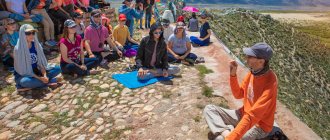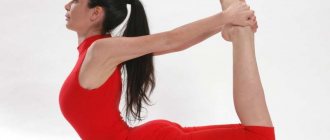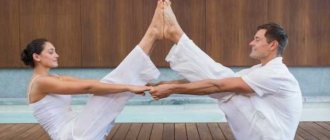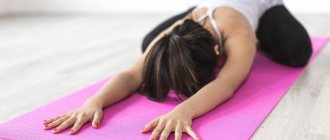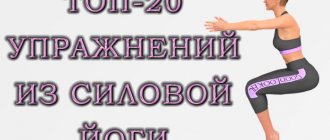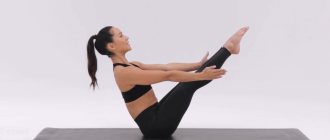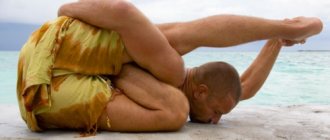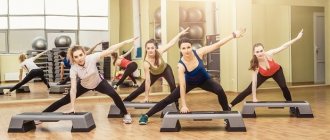The first acquaintance with the practice of yoga begins with a slight shock from the huge number of poses, each of which has its own name and characteristics of its effect on the body. Trying to memorize each one by approaching the lessons like a school lesson will not work. All knowledge comes gradually. The longer you practice yoga, the more techniques you master.
Don't be tempted to do difficult poses right away. It is always necessary to start with the basics and the simplest techniques. This is true not only for yoga, but also for any sports discipline. Mastering simple asanas is not just preparation for more complex poses, but also a huge benefit for the body. Most basic movements do not lose their relevance even for those who have been practicing yoga for a long time.
The main advantage of all asanas, regardless of the level of difficulty, is that they can be performed at home and do not require any special equipment. It is enough to buy a special mat and comfortable clothes. To make your first lessons easy and simple, you can use the program below, which describes the basic, most useful and effective thirty poses.
Types of poses
There are different poses in yoga. They are divided into several types, each of which determines a specific effect. Exercises fall into five main categories.
standing
Most often performed at the beginning of a lesson as a warm-up. Asanas performed from a standing position are the most difficult for beginners. Hatha yoga practices these asanas separately and involves rest between them, and Vyansa flow - a cycle when they follow one after another, which helps build ligaments.
To develop balance
This category of exercises is considered the most important and useful for beginning practitioners. It helps you develop balance and strengthen your core muscles. This is extremely important for further training and performing complex poses. Maintaining balance in the first lessons will be quite difficult, but after some time the improvements will become noticeable.
Bridges
Some of the most uncomfortable asanas for most beginners. Such poses should be mastered with light bending and stretching of the spine. In everyday life, such movements are performed extremely rarely, which is the cause of numerous problems with the musculoskeletal system. This makes these poses simply necessary to maintain the spine in good and healthy condition.
In a sitting position
Seated exercises focus on stretching the hamstrings and hips. These poses are usually done at the final stage of training, since the body is maximally warmed up and the muscles are ready for such a load. To increase the comfort of the pose, it is recommended to use a block or a folded regular blanket, which is placed under the buttocks.
For relaxation and on the back
These asanas allow you to rest between individual movements. Child's pose provides a particularly good respite. Techniques that are performed in a lying position are aimed at stretching tendons and muscles, and also help with twisting and bending.
Yoga for beginners. Olga Borodina
Why don't people write reviews about real yoga?
When we started creating a website for our yoga school, we asked many of our long-time students to write reviews. But many refused. Not because they were lazy or had nothing to say. They said, “This is too personal. This is too deep. It's impossible to describe in words." The real, deep experience of being in touch with your nature truly cannot be described in words. It can only be experienced. Instead of searching and reading reviews, just look at people who have been practicing yoga for a long time. How they live, how they behave, how they react to difficulties or troubles, what kind of relationships they have with other people, what their mood is usually. Think: would you like to be like them?
Basic yoga asanas with photos and descriptions
Bridge Pose (Bandha Sarvangasana)
It is a bridge that gently stretches and improves the mobility of the spine. Thanks to this exercise, you can eliminate the negative consequences of prolonged sitting, because most modern people spend most of their lives in this position. It’s okay if the pose seems difficult at first. The comfort of the asana in the first classes allows you to increase the block that is placed under the back.
Chakravakasana
Another pose of the “bridge” type, which allows you not only to stretch and improve the curvature of the spine. Thanks to the movement up and then down, the back warms up and literally “awakens”. This has a positive effect on your well-being and allows you to prepare for Vinyasa and balance your breathing with movement.
Child's Pose (Balasana)
A resting pose that is the most important for all beginners to practice yoga. It stretches the hips and spine, but that's not the only effect it has. Thanks to this asana, you can take a break between poses without compromising your practice, since it works to benefit the body. There is no need to wait for the right time to take this asana. If the body gives signals that it needs a little rest, you can safely take this pose.
Shoemaker Pose (Badha Konasana)
Sitting asana, often called cobbler's pose, is a body position that stretches the inner thighs. The first time, the exercise can be performed while sitting on a blanket or block, which will allow the knees, since the hips are slightly higher than when sitting on the mat, to open as naturally as possible. Keeping your knees high is much more difficult than it might seem, but you shouldn't strain your legs. Correct technique means that they are completely relaxed. To improve the beneficial effects of this movement, place something under the knees.
Cobra Pose (Bhujangasana)
It is a bridge called cobra pose. Consistent performance of asanas in Vinsyasa requires repeated repetition of this movement during each lesson. A full-fledged pose involves the cobra being done with the arms straightened at the elbow joints, with a deep arch in the back. There is also an easier variation that is suitable for beginners. It is performed without emphasis on the arms, that is, with bending of the chest alone. Both options involve securing the pelvis to the floor surface before lifting.
Savasana
A peaceful resting asana, also called the dead man's pose. It is performed at the end of each lesson and allows you to fully record the effect obtained and safely make the transition to everyday life. In yoga, the body is completely subject to movement, and the mind is released. When you take a completely motionless position, at first it seems uncomfortable and does not give you peace, but after a certain time it begins to be much easier and a feeling of calm comes almost immediately.
Mukha Svanasana
This is a fairly popular and widespread asana that allows you to achieve a versatile effect. Movement is included in almost every lesson. This body position is not natural. At first it is difficult, but pretty soon it begins to be easy and allows you to rest peacefully. It is not necessary to keep your legs completely straight in this position. The ability to bend your knees makes the movement accessible to many.
Downward Facing Dog Pose
A balance pose similar to the previous asana. It improves coordination and strengthens the core muscles. From the starting position, raise the leg upward. The emphasis is on the position of the hips at the moment the leg lifts off the floor. The height to which the leg rises is of secondary importance.
Sakhasana
A sitting simple pose that many beginners find one of the most difficult when they look at yoga practitioners. Sitting cross-legged is quite difficult for most people and becomes the main reason why people do not continue their exercise. There is nothing wrong with the fact that the asana is difficult. It will definitely work if you first use supports. The main advantage of the technique is that it allows you to get rid of the negative consequences that result from prolonged and frequent sitting on a chair.
Utthita Parsvakonasana
Standing right side angle pose can be done with the hand on the outside of the foot, but this position is not suitable for everyone. The hand can be placed on the block either inside or outside the foot, placing the forearms opposite the hips. This position is especially suitable for beginners. The main thing is that your hands do not create obstacles to opening your chest towards the ceiling.
Garland Pose (Malasana)
Standing Garland Pose. It allows you to compensate for the lack of such an important movement as squats in a person’s daily life. For the corresponding effect, the exercise is often called a “opener” for the hips. This does not mean that it only affects these muscles. The asana has a beneficial effect on the feet, which are almost never given attention. In cases where squats from such a position are difficult, resort to support.
Ardha Uttanasana
A standing asana or half-bend is performed with a straight back and is often included in the “Sun Salutation” complex, but rather quickly, which does not allow it to be given enough deserved attention. Beginners are strongly recommended to perform this pose as a separate practice. It allows you to learn to feel and control your own body. It is better to monitor the plane of your back at first using a mirror. It is not recommended to completely lower your arms onto your palms, using the latter as support for better balance. It is better to place your hands on your legs in such a way that it is easier to keep your back straight.
Ardha Matsyendrasana
The sitting half asana of the lord of the fish is a twisting exercise that is an essential part of yoga practice. They improve spinal mobility and have a beneficial effect on the function of the digestive system. These twists are especially good for constipation. If the bent lower leg interferes with mastering the exercise, it can be straightened during the first lessons.
Ananda Balasana
Happy Child's Pose is often chosen as the final pose for a yoga class. It allows you to well balance two states - relaxation and tension. Pressing on the feet in order to press the legs to the armpits as much as possible should only be done until the tailbone does not come off the floor. If it starts to rise, you need to stop. The golden mean is important here, not extremes.
Janu Sirsasana
The sitting head-to-knees pose is difficult for anyone who has problems with the elasticity of the hamstrings, which is the majority. Refusal to perform bending will not solve the problem, so this asana is recommended. It allows you to stretch not both legs at the same time, but one leg and then the other.
Ashtanga Namaskara
This bridge pose is usually unfairly excluded from classes or performed quite rarely, which leads to some problems. It is this bridge that allows you to prepare for Chaturanga and be completely ready to perform the sequence in the “Sun Salutation” complex. The exercise not only prepares you for other more complex asanas, warming up the muscles, which makes it easier and better to perform deep bends.
Legs up along the wall (Viparita Karani)
The resting pose, when the legs are raised up along the wall, does not cause any problems with compliance with the execution technique. It will be especially pleasant and useful for those who walk a lot. To fully recover and feel better, you can linger in this position for several minutes.
Lunge
It is a standing pose in which special attention is paid to body position. When performing a lunge, you need to make sure that all angles are correct, that is, the thigh is parallel to the floor and the knee is located above the foot. The back leg should be straight. Some beginners don't lean forward enough, causing their back leg to bend. To hone the technique of performing the asana, it is recommended to perform the pose in front of a mirror.
Mountain Pose (Tadasana)
The standing mountain pose is one of the most important in the practice of yoga and is mentioned in almost all asana complexes recommended for mandatory performance. It seems quite simple, but this is just the first impression. Tadasana requires balance, which is important for all standing poses and overall coordination. Having taken this pose and remaining standing in it for a while, you can safely move on to other asanas.
Plank
A balance pose that makes it almost impossible for you to fall is one of the best postures to strengthen your core muscles. The more developed the latter are, the better the asanas from a standing position and exercises performed on the hands are, and the process of transition to more complex movements is also accelerated. By doing planks, you can become more resilient and not experience problems with coordination and balance.
Pyramid Pose (Parsvottonasana)
Standing pyramid pose involves bending forward, which creates something like a pyramid. If it is difficult to achieve this position by stepping one foot forward and leaning back, blocks are placed on the left and right sides of the leg, which allows you to place your hands comfortably. This will not reduce the effect, since the hamstrings will be used in any case, and therefore will receive a good load.
Raised Arms Pose (Urdhva Hastasana)
Another pose of the “standing” type, but based on the “mountain” asana. Performing this exercise requires standing firmly on your feet while reaching your arms up. Thanks to this movement, the body is completely stretched. This asana is an excellent step to begin strength yoga practices.
Supta Padangusthasana
A resting pose, also called pulling back the big toe, which is accomplished by using the hands. The full version of this asana is not suitable for beginners, who are recommended to perform the lighter version. If you do a difficult pose right away, you should use a belt that will keep your shoulders on the floor and your leg straight.
Seated Forward Bend (Paschimottanasana)
Bend forward from a sitting position, which allows you to work out the tendons and muscles of the thigh well. Performing this and similar exercises allows you to avoid shortening the muscle tissue and tendons of the back of the thigh, and, therefore, not experience pain in the back. This exercise is often used as a therapeutic exercise. It is also preventive. The sooner you start doing asana, the lower the risks of having problems in the future.
Upavistha Konasana
Performing bends in a seated position with your legs spread wide apart creates a different stretch than the poses discussed previously. For beginners, touching your chest to the floor is quite difficult. Everyone will be able to achieve this goal after some time, but first you should concentrate on keeping your back straight and your pelvis turned as much as possible in the direction of the tilt being made. The movement should not be made by bending the spine, so the feet are kept motionless. If the technique is performed correctly, the depth of the inclination does not matter much.
Staff Pose (Dandasana)
Staff pose is often referred to as the mountain pose. Both poses are of the “sitting” type. Dandasana is performed with a straight back. For beginners who find it difficult to assume this position, it is recommended to place a rolled blanket under them, which will allow the pelvis to be lifted and slightly tilted forward, and the spine to be in a more comfortable position. This “trick” can be used in absolutely any sitting position.
Lying Twist Pose (Supta Matsyendrasana)
The abdominal twist from a lying position is one of the poses that is performed at the end of the session. You can do this asana at the beginning, since there are no strict restrictions regarding this. The position of the legs can also be one that is comfortable. For people who are not naturally flexible, the upper leg can be kept straight. In addition, rotation of one leg in relation to the other is allowed (as in eagle asana), which also allows you to stretch the outer thigh.
Tree Pose (Vrksasana)
Tree balance pose is recommended for all beginners, as it perfectly helps maintain balance. To avoid falling while performing an asana, just take a step. It is not recommended to move your hips further to the sides. This reduces the effectiveness of the exercise.
Extended Triangle Pose (Utthita Trikonasana)
The standing extended triangle pose is performed by many beginners using a block. With the extra height at hand, the front leg straightens without locking the knee and the chest opens up rather than pointing toward the floor.
Warrior Pose I (Virabhadrasana I)
The first version of the standing warrior pose. This asana is a classic one, covering several practices and styles. The first pose is more difficult than the second, since the pelvis faces forward in a similar way to the position of the mountain pose, and the legs stand completely differently.
Warrior Pose II (Virabhadrasana II)
The second pose differs from the first in position. The back leg is positioned so that the pelvis faces the mat rather than forward, which is why this variation of warrior pose is called open. It is important here to be able to control the position of the pelvis, which in the future will allow you to easily take a position and take more complex poses.
True goals
The concept of “yoga” came to our world from Sanskrit: the word “eugene” contains the meaning of unification, connection, community, union.
This means that the main goal of yoga is to connect our inner “I” with the higher, to unite the bodily perception of ourselves with the spiritual.
Our perfect, wise higher “I” is called differently in the culture of other countries, but this does not affect the essence of its understanding.
For example, you may hear this divine energy referred to as the soul, God, Atman, the Absolute, the Inner Sage, the voice of the Universe, or the Supreme Mind.
The epithets characteristic of a given entity are different in each religion. One thing is important - with the help of yoga, a person begins to follow his true path from external to internal, begins to understand the highest laws of existence. Finds his purpose to benefit the world around him.
One of the goals of yoga is to learn to control your mind and use the acquired knowledge for the right purpose. When thoughts get out of control, a person becomes a selfish, restless person, filled with all kinds of fears. He cannot feel happy, calm and harmonious.
The main canons of yoga are written in ancient books that have survived to this day.
The most authoritative of them, in our opinion, are the following:
- Yoga Sutras of Patanjali with commentaries;
- Hatha Yoga Pradipika;
- Three-volume book of the Bihar School of Yoga;
- Hatha Yoga Dipika (B.K.S. Iyengar).
Where to start doing yoga
The desire to start practicing yoga is an important decision, which means that a person is ready to practice. It remains only to decide on some nuances. You can study both at home and in a section. Here everything depends on your own preferences. The main thing is to take into account what is systematically of paramount importance.
Which type of yoga to choose?
There are many varieties of yoga practice. There are those that are not suitable for beginners and require some good physical preparation. To choose the style that best suits both your own level and your goals, you need to familiarize yourself with the features of each in advance.
For beginners and most people, Vinyasa or Hatha is most suitable. These styles are basic. They differ only in tempo - fast and slow. You need to choose what is more acceptable to your inner worldview. Further, when the practice of yoga ceases to be something new, and the level of physical fitness becomes much better, you can move on to a more complex style.
Find a yoga class
No videos or books can replace a professional instructor. If it is not possible to attend classes, you should choose video materials rather than a paper manual. Yoga classes are available in many fitness centers. They usually offer group lessons, but you can also find a personal instructor. The main thing is that he is sufficiently qualified and professional.
What to expect from the classes?
Typically, yoga classes are equipped with everything necessary for classes. On the first day, you will only need to have comfortable, breathable clothing with you. You can take a mat with you if you are not sure in advance that there is one in the gym. Place the mats in a checkerboard pattern so that there is free space nearby and no obstacles are created for people nearby to perform asanas. Those who have been practicing yoga for a certain time at the beginning of the class do light stretching or sit with their legs crossed.
Classes are usually held in the following order:
- Instructors may suggest that students begin class with meditation practice, breathing exercises, and chanting three “ommms.”
- Next, they move on to performing postures to warm up the muscles, active ones, stretching, and finish with relaxation, that is, resting asanas. At any time when you feel very tired, you can take the child's pose.
- Some instructors walk around the class at the end of class, when students are relaxing, and offer advice. The lesson may end with singing “ommm.”
The next day after the first lesson, the muscles may ache. This is a normal phenomenon, especially when a person does not exercise on a regular basis.
Home workouts
Not everyone can or wants to go to classes and perform asanas with others. This may be caused by simple embarrassment regarding the awkwardness of one’s own movements. Of course, if the latter is the case, you can simply go to a trial lesson, and if the feeling of discomfort and self-doubt does not go away, you can practice yoga at home for the first time.
In order for yoga classes to bring maximum benefits, you should listen to the following important recommendations:
- daily exercises should be based on the principle: fifteen minutes of stretching, followed by an extended workout, lasting from 30 to 45 minutes;
- if you have free time, you should add new asanas to your program, which will speed up your progress;
- It is recommended to practice every day, but missing one lesson is not critical.
You have to study at home longer than in the classroom, so many people prefer to visit the center and perform asanas on their own when they have some free time.
In principle, no special equipment is required, but you will need to purchase some things. A yoga mat is required for classes. If you plan to perform asanas at home, you should buy blocks, a comfortable blanket, and a belt.
#Yoga for beginners at home - where to start in yoga
What beginners need to know
What else is important to know before you start.
- Yoga is a set of exercises (asanas), usually in a certain sequence. The class ends with a resting pose - shavasana: in it your body should be absolutely motionless for 10-15 minutes. This time is enough for the body to relax and rest as much as possible, and for the brain to overload (yes, like a frozen computer).
- You should not experience any pain while practicing yoga at home. None at all! There is no need to specifically stretch your muscles (this is not a sport!), bend down with force, pull your legs - and at the same time endure. Even more so for beginners. You have just started working with the body, give it time, and you will soon see how you will become more flexible. Learn to listen to your body. If any unpleasant sensations arise, relax the effort or carefully exit the asana.
- Before starting, it is better to do a short warm-up to warm up your muscles.
- And breathe evenly, calmly in asanas! Control your breathing: there should be no delays, inhale and exit as deeply and slowly as possible. It is very important.
30-day at-home yoga program for beginners
The first month of classes can take place according to an already developed general program. It allows you to start practicing yoga at home, learn basic movements and improve your level of physical fitness.
The first day
- Start your session with stretching.
- Add three cycles of sun salutations.
- Rest for a few minutes in the dead man's pose.
Week 1
During the first week of classes, stretch every day and do Sun Salutations every other day. Combine standing and sitting poses during your workouts for a longer session at least three times a week. Remember to rest in Repose Pose at the end of each session.
Think about what time works best for you to study. A good opportunity to do yoga in the morning, you can start the day with stretching, find the best time.
Procedure for the first week:
- Day 1: stretching + 3 times Sun Salutation complex.
- Day 2: stretching + 3 times Sun Salutation complex + stretching in a sitting position.
- Day 3: Stretching.
- Day 4: stretching + 3 times Sun Salutation complex + stretching in a standing position.
- Day 5: Stretching.
- Day 6: stretching + 3 times Sun Salutation complex + stretching in a sitting position.
- Day 7: Stretching.
For the remainder of the month, you will perform short stretches daily and add variations to longer sequences of poses.
Week 2
- Day 1: Stretching.
- Day 2: stretching + 3 times Moon Salutation complex + sitting stretching + standing stretching.
- Day 3: Stretching.
- Day 4: stretching + 3 times Moon Salutation complex + standing stretches + balance poses.
- Day 5: Stretching.
- Day 6: stretching + 3 times Moon Salutation complex + standing stretching + yoga for the abs.
- Day 7: Stretching.
Week 3
- Day 1: Stretching.
- Day 2: stretching + 3 times Surya Namaskar + sitting stretching + standing stretching.
- Day 3: Stretching.
- Day 4: stretching + Surya Namaskar + standing stretching + balance poses + sitting stretching.
- Day 5: Stretching.
- Day 6: stretching + 3 times Surya Namaskar + standing stretching + yoga for the abs.
- Day 7: Stretching.
Week 4
- Day 1: Stretching.
- Day 2: stretching + 3 times Surya Namaskar + sitting stretching + standing stretching + arm yoga.
- Day 3: Stretching.
- Day 4: stretching + Surya Namaskar + standing stretching + balance poses + sitting stretching.
- Day 5: Stretching.
- Day 6: stretching + 3 times Surya Namaskar + standing stretching + abdominal yoga + sitting stretching.
- Day 7: Stretching.
The thirty-day workout program is a great way to start practicing yoga. It does not include overly complex elements. Regularly performing the same exercises allows you to master the technique and understand the basic principles of yoga. In the future, you can complicate the program and add new elements. And if in the first week there are no significant improvements in well-being, from the second week and subsequent days you can notice a significant improvement in tone and physical fitness. In addition, systematic exercise develops the habit of constantly performing asanas, and a person already develops the need to practice and practice when the process begins to bring true pleasure.
Important nuances
There are some important points that should be taken into account both for those who exercise at home and for people attending a yoga class at a fitness center. They concern what is not recommended and, conversely, what should be done.
It is forbidden:
- You should refrain from eating a heavy lunch or dinner. If classes are held in the morning, then from breakfast. A light snack should be no earlier than a few hours before the start of classes. This is much longer than for other physical activities.
- Drink fluids during class. To avoid feeling thirsty, you should drink plenty of water before exercise and then after.
- Exercise in shoes or socks. Asanas are done exclusively on bare feet.
It can be done better:
- If you purchase a subscription, then at the very first lesson you must tell the instructor about your level of physical fitness and experience in practicing yoga. Lessons are often held divided by level.
- Ask the instructor about things you don’t understand and don’t be shy about asking for help if something doesn’t work out.
- If something doesn’t work out in the first lesson, don’t be upset. Soon, asanas will be easy and simple, so you shouldn’t refuse to continue classes immediately after your first visit to the fitness center.
Proper nutrition. Vegetarianism
Having completed several shatkarmas, such as shankaprakshalana, it is much easier to switch to adequate nutrition, conducive to yogic practice - vegetarianism.
At the World Health Organization, in a recent report dated October 26, 2015, 22 experts from 10 countries presented the results of 800 scientific studies, according to which meat products were recognized as carcinogens, directly affecting the development of cancer in humans.
Vegetarianism or a more fashionable trend now - veganism, is very popular in the West because... has obvious health benefits that can be noticed quickly enough by switching to proper nutrition. Famous actors and actresses, singers, directors, bodybuilders, famous politicians and many other modern figures advocate a healthy lifestyle, which can start with your diet. Here is just a small list of famous vegetarians of our time: Uma Thurman, Tobey Maguire, Richard Gere, Paul McCartney, Natalie Portman, musician Moby, famous former boxer Mike Tyson, Kim Basinger, Jim Carrey, Demi Moore, Brad Pitt, Alicia Silverstone, Olga Shelest , Nikolai Drozdov, Mikhail Zadornov, Alexey Voevoda and many others, the list can be continued for a very long time.
“How can we hope that peace and prosperity will reign on earth if our bodies are living graves in which killed animals are buried!?”, so said the famous Russian writer Lev Nikolaevich Tolstoy, seeing the reality around him.
However, if you have been eating meat for a long time or throughout your life, you should carefully switch to a kill-free diet, because A sudden change in diet can lead to a deterioration in well-being. To help you understand this issue, we have prepared a very detailed section on nutrition, which will answer your questions about vegetarianism and raw food diet - Proper nutrition. Also, you should not be fanatical about nutrition; it is important to get tested regularly for vegetarians. In case of a lack of any vitamins and microelements, the deficiency should be compensated with the help of supplements. More than 1 billion people on our planet live fully without meat.

